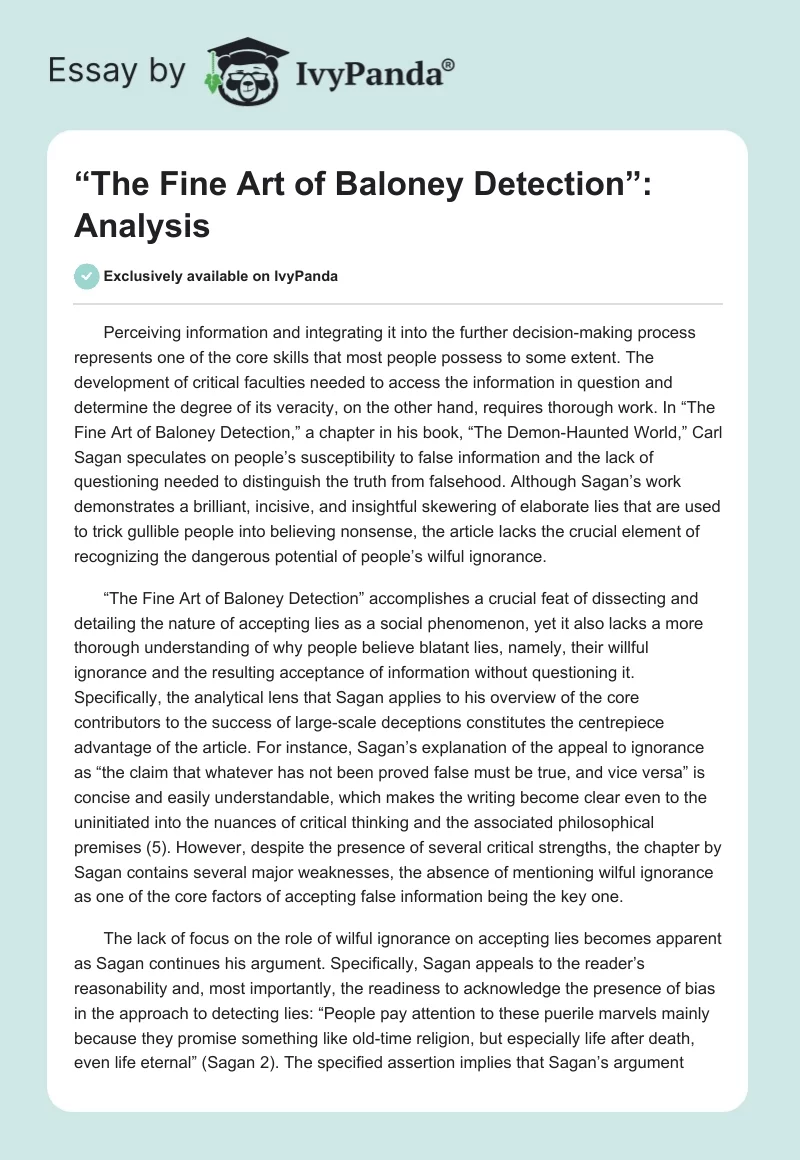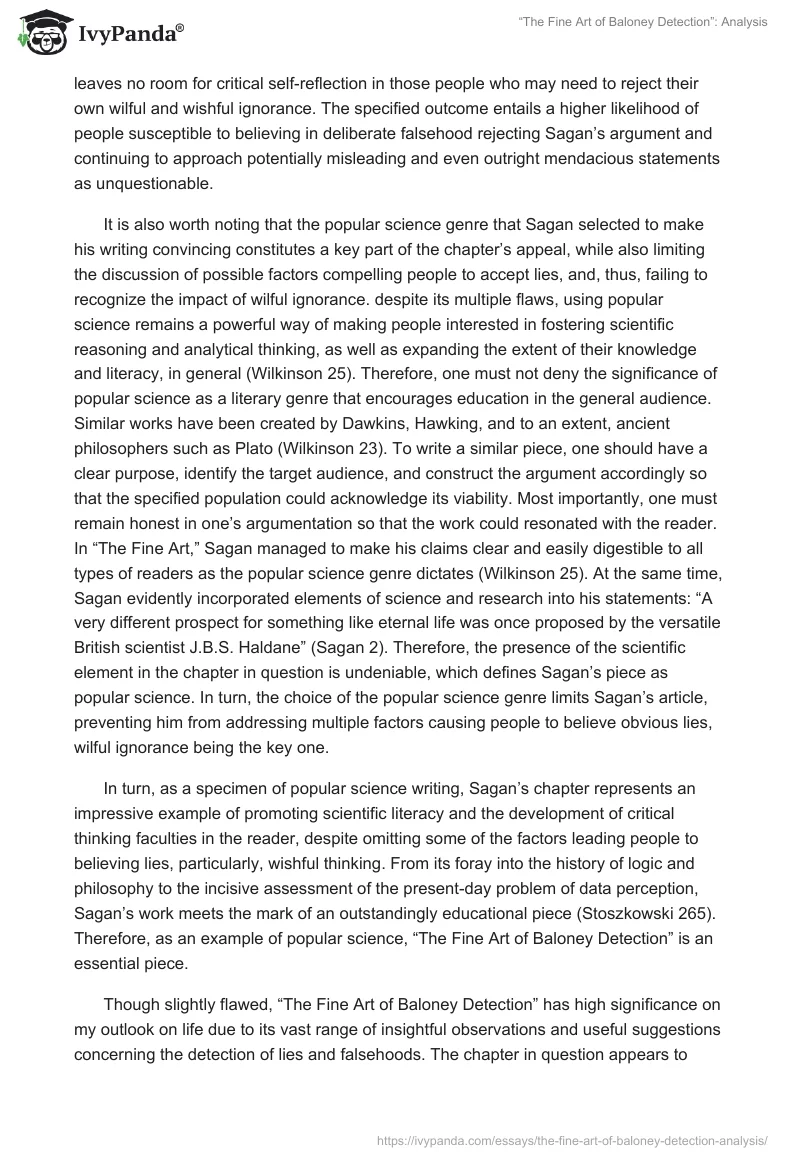Perceiving information and integrating it into the further decision-making process represents one of the core skills that most people possess to some extent. The development of critical faculties needed to access the information in question and determine the degree of its veracity, on the other hand, requires thorough work. In “The Fine Art of Baloney Detection,” a chapter in his book, “The Demon-Haunted World,” Carl Sagan speculates on people’s susceptibility to false information and the lack of questioning needed to distinguish the truth from falsehood. Although Sagan’s work demonstrates a brilliant, incisive, and insightful skewering of elaborate lies that are used to trick gullible people into believing nonsense, the article lacks the crucial element of recognizing the dangerous potential of people’s wilful ignorance.
“The Fine Art of Baloney Detection” accomplishes a crucial feat of dissecting and detailing the nature of accepting lies as a social phenomenon, yet it also lacks a more thorough understanding of why people believe blatant lies, namely, their willful ignorance and the resulting acceptance of information without questioning it. Specifically, the analytical lens that Sagan applies to his overview of the core contributors to the success of large-scale deceptions constitutes the centrepiece advantage of the article. For instance, Sagan’s explanation of the appeal to ignorance as “the claim that whatever has not been proved false must be true, and vice versa” is concise and easily understandable, which makes the writing become clear even to the uninitiated into the nuances of critical thinking and the associated philosophical premises (5). However, despite the presence of several critical strengths, the chapter by Sagan contains several major weaknesses, the absence of mentioning wilful ignorance as one of the core factors of accepting false information being the key one.
The lack of focus on the role of wilful ignorance on accepting lies becomes apparent as Sagan continues his argument. Specifically, Sagan appeals to the reader’s reasonability and, most importantly, the readiness to acknowledge the presence of bias in the approach to detecting lies: “People pay attention to these puerile marvels mainly because they promise something like old-time religion, but especially life after death, even life eternal” (Sagan 2). The specified assertion implies that Sagan’s argument leaves no room for critical self-reflection in those people who may need to reject their own wilful and wishful ignorance. The specified outcome entails a higher likelihood of people susceptible to believing in deliberate falsehood rejecting Sagan’s argument and continuing to approach potentially misleading and even outright mendacious statements as unquestionable.
It is also worth noting that the popular science genre that Sagan selected to make his writing convincing constitutes a key part of the chapter’s appeal, while also limiting the discussion of possible factors compelling people to accept lies, and, thus, failing to recognize the impact of wilful ignorance. despite its multiple flaws, using popular science remains a powerful way of making people interested in fostering scientific reasoning and analytical thinking, as well as expanding the extent of their knowledge and literacy, in general (Wilkinson 25). Therefore, one must not deny the significance of popular science as a literary genre that encourages education in the general audience. Similar works have been created by Dawkins, Hawking, and to an extent, ancient philosophers such as Plato (Wilkinson 23). To write a similar piece, one should have a clear purpose, identify the target audience, and construct the argument accordingly so that the specified population could acknowledge its viability. Most importantly, one must remain honest in one’s argumentation so that the work could resonated with the reader. In “The Fine Art,” Sagan managed to make his claims clear and easily digestible to all types of readers as the popular science genre dictates (Wilkinson 25). At the same time, Sagan evidently incorporated elements of science and research into his statements: “A very different prospect for something like eternal life was once proposed by the versatile British scientist J.B.S. Haldane” (Sagan 2). Therefore, the presence of the scientific element in the chapter in question is undeniable, which defines Sagan’s piece as popular science. In turn, the choice of the popular science genre limits Sagan’s article, preventing him from addressing multiple factors causing people to believe obvious lies, wilful ignorance being the key one.
In turn, as a specimen of popular science writing, Sagan’s chapter represents an impressive example of promoting scientific literacy and the development of critical thinking faculties in the reader, despite omitting some of the factors leading people to believing lies, particularly, wishful thinking. From its foray into the history of logic and philosophy to the incisive assessment of the present-day problem of data perception, Sagan’s work meets the mark of an outstandingly educational piece (Stoszkowski 265). Therefore, as an example of popular science, “The Fine Art of Baloney Detection” is an essential piece.
Though slightly flawed, “The Fine Art of Baloney Detection” has high significance on my outlook on life due to its vast range of insightful observations and useful suggestions concerning the detection of lies and falsehoods. The chapter in question appears to bear additional significance nowadays, when constant exposure to a vast range of media, specifically, online ones, requires being able to differentiate between the truth and misinformation. Indeed, according to Machete and Turpin, the increase in the extent of information availability that the Internet provides has led to a surge in the number and frequency of fake news surfacing : “any person who is in possession of a device, which can connect to the internet, is potentially a consumer or distributor of fake news” (236). Therefore, living in the era of digital communication and prevalence of digital resources as the repository of news and the related information makes me particularly susceptible to being tricked into believing deliberate lies. Consequently, Sagan’s chapter on discerning truth and falsehood is of crucial significance to me since it allows me to navigate the digital environment without succumbing to believing silly or downright harmful misinformation.
Despite being an outstanding exposé on the intricate lies that are woven to confuse naive people, Sagan’s “The Fine Art of Baloney Detection” lacks a crucial component, namely, the acknowledgment of the role that wilful ignorance of a substantial part of the population plays in them being deceived. As a result, the article, while being obviously helpful for those who have built the platform for a critical assessment of questionable information., may fail to convince those that are not ready to engage in a critical analysis. Therefore, though being a major stepping stone in building the skillset for detecting falsehood, especially that one spread with the intent of abusing people’s unwavering faith for personal profit, the chapter omits a major opportunity. Specifically, it does not speak directly to some of the most vulnerable groups that may need to revisit their perception of reality and abandon the stated of wilful ignorance.
Works Cited
Machete, Paul, and Marita Turpin. “The Use of Critical Thinking to Identify Fake News: A Systematic Literature Review.” Conference on e-Business, e-Services and e-Society. Springer, Cham, 2020, pp. 235-246.
Stoszkowski, John, et al. ““Opinion and Fact, Perspective and Truth”: Seeking Truthfulness and Integrity in Coaching and Coach Education.” International Sport Coaching Journal, vol. 8, no. 2, 2020, pp. 263-269.
Wilkinson, David A. “Pop Science and Pop Theology: New Ways of Exploring an Old Dialogue.” Theology 123.1 (2020): 20-27.


